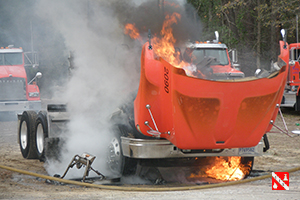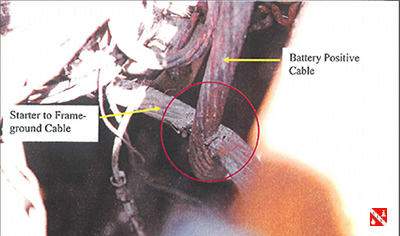
In the fire investigation industry, the cause of a truck fire often relates to preventative maintenance or lack thereof. In fact, the most common causes for truck fires that I have investigated can be broken down into two categories:
- Wheel, brake or tire failures
- Hose or wiring insulation failure
In both categories, many of these failures are preventable with proper preventative maintenance. Rigid preventative maintenance inspections that ensure proper lubrication in the wheel bearings and identify any leaks can reduce the risk of a frozen or locked bearing. The National Transportation Safety Board states that “daily inspection of hub oil levels and wheel seals is vital to prevent wheel bearing failure and that bypassing this requirement is a dangerous practice that can lead to a wheel fire or other serious consequences.” Tires in poor condition or severely underinflated also pose a fire risk as does a faulty brake system. Dragging brakes, for example, can produce significant heat and may not be readily identifiable to the operator, who continues to drive the truck unaware of a problem with the brakes. A carefully inspected brake system can significantly reduce the risk of fire incidents.
Likewise, taking the time to check fluid hoses or wiring insulation for cracking and general degradation is an important procedure. However, emphasis should be placed on identifying areas where hoses or electrical cables are in direct contact with another object. Hidden damage at the point of contact, caused by vibration and abrasion, may be identifiable on a hose or cable that otherwise looks to be in excellent condition. Figure 1 depicts an electrical failure of the positive battery. In this matter, the positive battery cable was routed adjacent to a battery ground cable. The point where the battery cables intersected resulted in long-term abrasion of the insulation. Once the insulation for both cables was compromised, the electrical fault occurred and caused this fire.

The trucking company in this case asked me to inspect other trucks at their facility. In nearly every case, the visible inspection of the cable insulation would have passed a routine preventative maintenance inspection, as the visible insulation was in good condition. However, closer inspection at the contact point between the positive cable and ground cable identified several instances of severely damaged insulation.
In addition to a closer inspection of potential contact points, the mechanic should also pay particular attention to hoses, wiring insulation, harnesses and wiring looms located in close proximity to hot surfaces, such as at or near the turbocharger or downstream as the exhaust piping exits the engine compartment. It is important to not only inspect these items, but also any heat shields installed by the manufacturer to protect combustible materials from these hot surfaces. Were heat shields properly re-installed after a recent service, damaged or not re-installed at all?
Although fires only represent a small fraction of trucking accidents, they can be deadly and costly. To avoid this situation, a thorough preventative maintenance program that addresses these primary fire hazards may further reduce your risk of a catastrophic fire loss. Are you protecting your fleet from these potential hidden dangers? If you have additional questions please feel free to leave your comments or contact us for more information.
Michael Hoffman, IAAI-CFI, District Manager
Unified Investigations & Sciences | a Sedgwick company